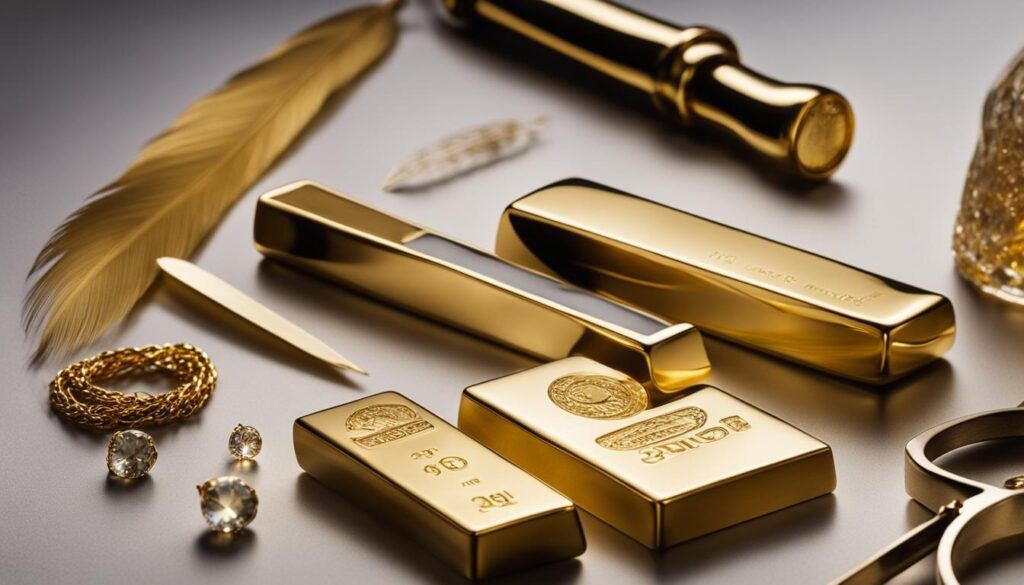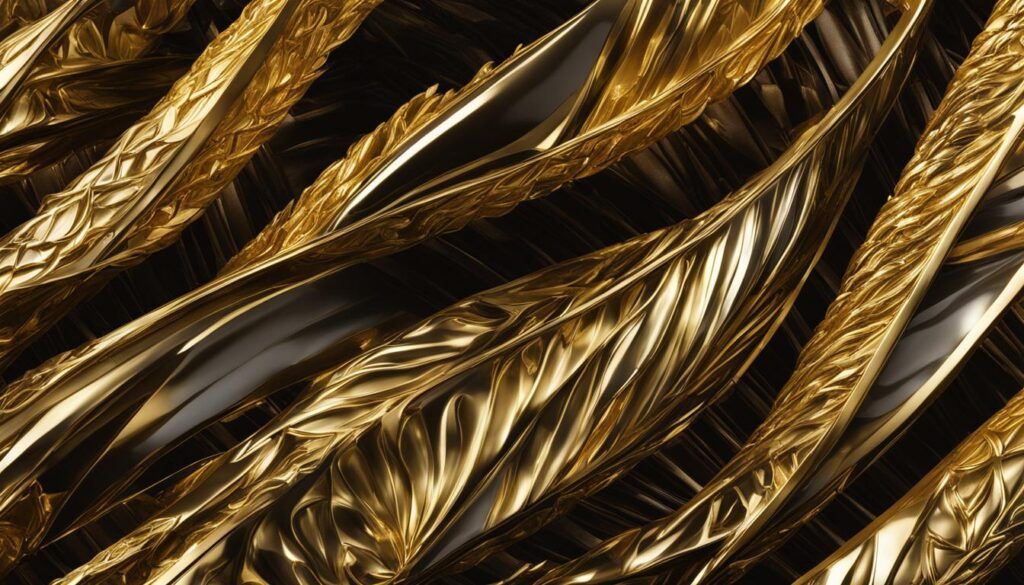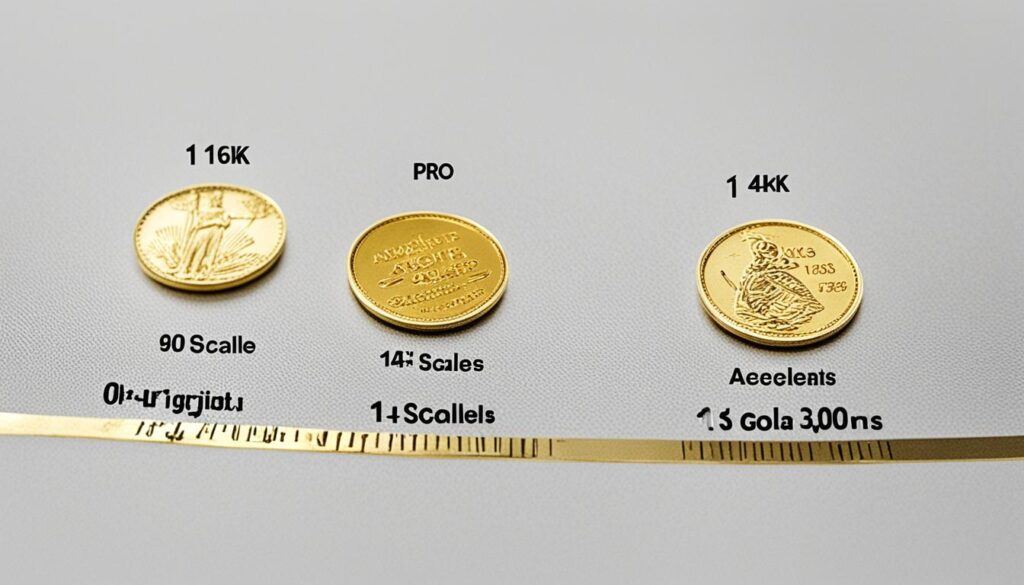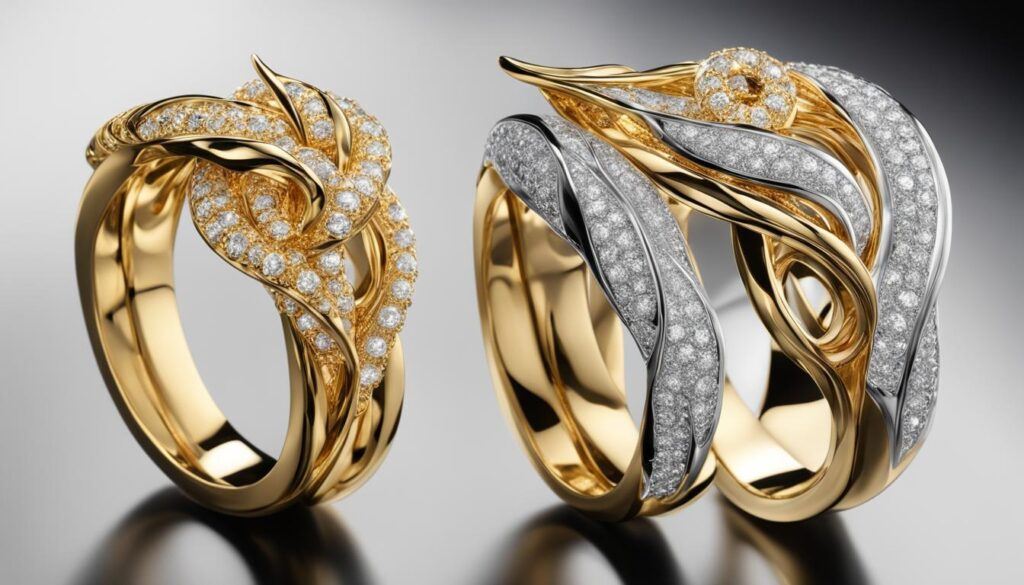When it comes to buying gold jewelry, one of the factors to consider is its softness. Gold, in its pure form, is a highly malleable and soft metal that may not be suitable for everyday wear. However, 18K gold, which contains 75% pure gold, strikes a balance between softness and durability, making it a popular choice for fine jewelry.
Compared to lower karat alloys like 14K or 10K, 18K gold has a higher percentage of pure gold, lending it a rich yellow color and a luxurious feel. Its softness, though less than pure gold, can still make it prone to scratches and bending, especially if the jewelry piece is thin or poorly made. However, with proper maintenance and care, 18K gold jewelry can withstand normal wear and tear.
Key Takeaways
- 18K gold is 75% pure gold and offers a good balance of softness and durability.
- It is less soft compared to pure gold but can still be prone to scratches and bending.
- Proper maintenance and care can help 18K gold jewelry withstand normal wear and tear.
- Thicker and well-made 18K gold pieces are more durable than thin or poorly crafted ones.
- Ultimately, the choice between 18K and lower karat gold depends on personal preferences and the intended use of the jewelry.
Understanding Gold Purity – Karat vs. Carat
Gold purity is measured in terms of karat, while carat is a measurement of a gem’s weight. Karat refers to the percentage of pure gold in an alloy. Pure gold is 24K, which is 100% gold. 18K gold is 75% pure gold, 14K is 58.3% pure, and 10K is 41.7% pure. The remaining percentage is made up of other metals like copper, silver, and nickel, which are added to increase the strength and durability of the gold.

| Karat | Purity |
|---|---|
| 24K | 100% |
| 18K | 75% |
| 14K | 58.3% |
| 10K | 41.7% |
Advantages and Disadvantages of 18K Gold
When it comes to choosing the perfect gold for your jewelry, 18K gold offers several advantages and disadvantages to consider. Understanding these aspects can help you make an informed decision. Let’s explore the benefits and drawbacks of 18K gold.
Advantages of 18K Gold
18K gold stands out for its high purity. With a gold content of 75%, it contains a larger percentage of pure gold compared to lower karat alloys like 14K or 10K. This higher gold content gives 18K gold a rich, vibrant yellow color that many people desire.
Another advantage of 18K gold is its good malleability. Its softer nature makes it easier for jewelers to create intricate designs and intricate details in jewelry pieces. The malleability of 18K gold allows jewelry to be crafted with fine details and delicate elements that may not be possible with other alloys.
Additionally, 18K gold is less likely to cause skin irritation due to its high gold content. It contains fewer other metals, such as nickel, which can be a common allergen for some individuals. Therefore, if you have sensitive skin, 18K gold may be a better choice for you.
Disadvantages of 18K Gold
While 18K gold offers many advantages, there are also some disadvantages to consider. One of the main drawbacks is its higher cost compared to lower karat alloys. The higher gold content and purity of 18K gold make it more expensive. If budget is a factor, you might consider exploring 14K or 10K gold options instead.
Another disadvantage of 18K gold is its lower resistance to scratching compared to alloys with a lower gold content. Due to its softness, 18K gold is more prone to surface scratches. This means that 18K gold jewelry may require more frequent polishing and maintenance to keep its shine intact.
Ultimately, the decision between 18K gold and other karat alloys depends on your personal preferences, budget, and the specific jewelry piece you have in mind. Taking into account the advantages and disadvantages of 18K gold can help you make an informed choice that suits your needs and style.

| Advantages of 18K Gold | Disadvantages of 18K Gold |
|---|---|
| High purity | Higher cost |
| Rich yellow color | Lower resistance to scratching |
| Good malleability | |
| Less likely to cause skin irritation |
Advantages and Disadvantages of 14K Gold
When it comes to jewelry, 14K gold offers a multitude of advantages. This alloy, composed of 58.3% pure gold, strikes a balance between purity, durability, and affordability, making it a popular choice for many individuals.
“14K gold provides a good balance of quality and cost, making it accessible to a wider range of customers.”
One of the key advantages of 14K gold is its hardness and scratch resistance. Compared to 18K gold, which contains a higher percentage of pure gold, 14K gold is more resilient and less prone to surface damage. This durability ensures that your jewelry will stand the test of time and maintain its lustrous appearance.
In addition to its durability, 14K gold also offers a slight weight advantage. Being less dense than 18K gold, jewelry crafted from 14K gold feels lighter on the wearer, providing a comfortable and enjoyable experience.
Moreover, the affordability of 14K gold makes it an attractive option for those seeking high-quality jewelry without breaking the bank. With a lower gold content compared to higher karat alloys, 14K gold allows for intricate designs and a wider variety of jewelry options, including rings, necklaces, bracelets, and earrings.
“The affordability of 14K gold makes it accessible to individuals looking for quality jewelry at a more budget-friendly price.”
However, it’s important to note that not all 14K gold alloys are free from drawbacks. Some blends may contain metals like nickel, which can cause skin irritation in sensitive individuals. If you have known allergies or sensitivities, it’s essential to choose 14K gold jewelry that is free from allergenic metals.
Overall, 14K gold combines the advantages of durability, affordability, and versatility, making it an excellent choice for a wide range of jewelry styles. Whether you’re looking for an engagement ring or a special gift for a loved one, 14K gold offers a reliable option that won’t compromise on quality or style.

The Softness of 18K Gold vs. 14K Gold
When comparing the softness of 18K gold and 14K gold, it’s important to consider their differences in composition. 18K gold contains a higher percentage of pure gold compared to 14K gold, making it slightly softer.
However, this difference in softness is not significant when it comes to well-made, substantial jewelry pieces. Both 18K and 14K gold can withstand normal wear and tear without issues, as long as the pieces are thick and of good quality.
Thicker jewelry pieces provide more strength and durability, regardless of the gold alloy used. Whether it’s 18K or 14K gold, a well-crafted and substantial piece will be able to withstand the test of time.
If you hear conflicting opinions about the softness of 18K gold compared to 14K gold, keep in mind that it ultimately depends on the craftsmanship and thickness of the jewelry. When in doubt, consult with a reputable jeweler who can guide you in choosing the right gold alloy for your specific needs.
Is 18K Gold Durable Enough for Jewelry?
When it comes to investing in jewelry, durability is a key consideration. Many people wonder if 18K gold, with its higher gold content, is durable enough for everyday wear. The answer lies in understanding the factors that contribute to the durability of gold jewelry.
Firstly, 18K gold is durable enough for jewelry when it is well-made and of substantial thickness. While it is true that pure gold is soft and malleable, the addition of other metals in the alloy helps to balance its softness and increase its durability. By blending gold with metals like silver, copper, or nickel, jewelers create a stronger and more resilient material without compromising the desired purity and rich yellow color.
The durability of gold jewelry also depends on how the piece is worn and cared for. While 14K gold is generally considered more durable due to its lower gold content, 18K gold can still withstand everyday wear with proper maintenance and care. Regular cleaning, storage in a safe place, and removing jewelry during activities that may subject it to excessive force or harsh chemicals contribute to preserving its durability and luster.
It’s worth noting that the durability of any gold jewelry piece, whether 18K or 14K, depends on its thickness and quality of craftsmanship. Thicker and well-made pieces are more likely to withstand normal wear and tear without issues. This is why it is essential to choose reputable jewelers and examine the quality and weight of the jewelry before making a purchase.
Overall, while 14K gold is generally considered more durable, 18K gold can still be a reliable choice for jewelry when the piece is crafted with substantial thickness and maintained with care. The durability of gold jewelry, regardless of its karat, ultimately comes down to the combination of materials, craftsmanship, and how it is worn and cared for.
The Durability of 18K Gold: A Comparative Analysis
| 18K Gold | 14K Gold | |
|---|---|---|
| Durability | Dependent on thickness and craftsmanship | Generally more durable due to lower gold content |
| Gold Content | 75% | 58.3% |
| Added Metals | Balance of other metals for increased strength | Balance of other metals for increased durability |
| Price | Relatively higher | Relatively lower |
| Appearance | Rich yellow color | Slightly lighter yellow hue |
As shown in the comparison table above, 18K gold offers a balance of durability, gold content, and appearance, making it a popular choice for high-end fine jewelry. While 14K gold may be more suitable for individuals with very active lifestyles or those who prefer lighter and thinner jewelry, 18K gold can still provide the desired durability for more substantial pieces like engagement rings and bracelets.

When to Choose 14K Gold over 18K Gold
When it comes to selecting between 14K and 18K gold, certain factors should be considered to ensure the jewelry piece suits your preferences and lifestyle. While both options offer their own advantages and qualities, there are specific instances where 14K gold may be more suitable.
Active Lifestyles and Manual Work: Individuals with active lifestyles or professions involving significant manual work might find 14K gold more appropriate. Due to its slightly lower gold content compared to 18K gold, 14K gold tends to be more durable and less prone to scratches, making it better suited for those engaged in physical activities.
Thinner and Lighter Pieces: If you prefer jewelry that is thinner and lighter, such as pendants or chains, 14K gold could be the preferable choice. Its composition provides the required strength and durability for delicate pieces while offering a cost-effective alternative.
However, it is important to note that if you seek thicker and more substantial jewelry pieces like engagement rings or wedding bands, 18K gold can provide the desired durability and strength. The additional gold content in 18K gold contributes to its rich color and elegance, making it a popular choice for special occasions.
Ultimately, the decision between 14K and 18K gold depends on your personal style, preferences, and the specific characteristics of the jewelry piece you desire. Consider your lifestyle, the type of jewelry you intend to wear, and the level of durability you require to make an informed choice.
The Impact of Metal Thickness on Gold Durability
When it comes to the durability of gold jewelry, the thickness of the metal used is a critical factor to consider. Thicker and more substantial pieces tend to be more durable compared to thinner and flimsier ones. Whether you choose 14K or 18K gold, the key is to ensure that the jewelry is crafted with sufficient thickness and quality for long-lasting durability.
“Thicker and more substantial pieces tend to be more durable compared to thinner and flimsier ones.”
Both 14K and 18K gold can be used to create durable jewelry if they are designed and manufactured with the right specifications. It’s important to choose jewelry pieces that have depth and substance, providing the necessary strength to withstand everyday wear and tear.
The Role of Metal Thickness
Thicker metal thickness enhances the overall strength and durability of gold jewelry. It provides a solid foundation that can resist bending, scratching, and accidental damage. The thickness also contributes to the weight of the piece, giving it a substantial feel and presence on the wearer.
When jewelry is crafted with a thicker metal gauge, it can better withstand the rigors of everyday life. It is less prone to warping, denting, or losing its shape over time. This aspect is particularly important for jewelry that is frequently worn and exposed to various activities.
Additionally, substantial gold jewelry tends to have a more polished and luxurious appearance, adding to its aesthetic appeal. It exudes a sense of quality and sophistication, making it a desirable choice for those seeking timeless and enduring pieces.
The Importance of Quality Craftsmanship
While metal thickness is crucial for durability, it is equally important to consider the overall quality of craftsmanship. Well-made jewelry ensures proper alignment and reinforcement of its components, enhancing its longevity.
When choosing substantial gold jewelry, look for:
- Seamless joints and connections between different parts
- Finely finished edges and surfaces
- Secure prong settings for gemstones
These elements contribute to the overall strength and durability of the piece, ensuring that it will stand the test of time with minimal maintenance and repairs.
Metal Thickness Comparison
| Gold Alloy | Metal Thickness | Durability |
|---|---|---|
| 14K Gold | 1.2mm | Durable |
| 18K Gold | 1.0mm | Durable |
| 14K Gold | 0.8mm | Less durable |
| 18K Gold | 0.6mm | Less durable |
The table above showcases the impact of metal thickness on gold durability. The thicker the metal gauge, the more durable the piece tends to be. It’s important to note that these are general guidelines and the actual durability of a piece depends on various factors, including its design, wear and care, and the wearer’s lifestyle.
By selecting jewelry with sufficient metal thickness and paying attention to quality craftsmanship, you can enjoy beautiful, substantial gold jewelry that will last for generations.
Scratching and Maintenance of 18K Gold
When it comes to the scratching of 18K gold, it is worth noting that it may be slightly more prone to surface scratches compared to 14K gold. This is primarily due to its higher gold content, which makes the metal slightly softer. However, it’s important to remember that these scratches are typically superficial and can be easily addressed with proper care and maintenance.
If you notice any surface scratches on your 18K gold jewelry, there are a few simple steps you can take to minimize their visibility. One option is to use a microfiber jewelry cleaning cloth to gently polish the affected areas. This can help smooth out the scratches and restore the jewelry’s lustrous appearance.
For more extensive scratches or if you prefer professional assistance, you can also consider taking your 18K gold jewelry to a jeweler for cleaning and polishing services. They have the expertise and tools to effectively remove scratches and bring back the shine of your beloved pieces.
In addition to addressing scratches, regular maintenance is key to keep your 18K gold jewelry looking its best. It is recommended to clean your jewelry regularly with a mild soap and warm water solution, using a soft brush or cloth to remove any dirt or residue. After cleaning, dry your jewelry thoroughly with a soft cloth to prevent moisture from causing tarnishing or discoloration.
Furthermore, it is advisable to store your 18K gold jewelry in a separate compartment or pouch to prevent scratching from contact with other harder objects. Avoid exposing your jewelry to harsh chemicals, abrasive materials, or extreme temperatures, as these can potentially damage the metal.
By following these simple maintenance practices, you can help preserve the beauty and shine of your 18K gold jewelry for years to come.
| Scratching | Maintenance |
|---|---|
| 18K gold may be slightly more prone to surface scratches compared to 14K gold | Clean regularly with mild soap and warm water |
| Surface scratches can be easily polished out with a microfiber jewelry cleaning cloth or professional services | Dry thoroughly with a soft cloth |
| Consider professional cleaning and polishing for more extensive scratches | Store separately to prevent scratching |
Conclusion
In summary, the softness of 18K gold compared to lower karat alloys like 14K gold is a matter of consideration when choosing fine jewelry. While 18K gold is softer, it is still a durable option for everyday wear when crafted with substantial thickness and high-quality craftsmanship.
The higher purity of 18K gold, at 75%, contributes to its rich yellow color and makes it a popular choice for high-end fine jewelry pieces. However, individuals with very active lifestyles or those who prefer thinner and lighter jewelry may lean towards 14K gold for its balance of durability and affordability.
Ultimately, the decision between 18K and 14K gold should consider personal preferences and the specific characteristics of the jewelry piece. Both options have their advantages and disadvantages, and it is important to choose based on individual style, comfort, and the desired level of durability.
FAQ
Is 18K gold soft?
18K gold is softer compared to lower karat alloys like 14K gold. However, it is still durable enough for everyday wear when well-made and of substantial thickness.
What is the difference between gold purity and carat?
Gold purity is measured in terms of “karat,” while carat is a measurement of a gem’s weight.
What are the advantages and disadvantages of 18K gold?
Advantages of 18K gold include its high purity, rich yellow color, and good malleability. However, it is more expensive compared to lower karat alloys and may require more frequent maintenance.
What are the advantages and disadvantages of 14K gold?
14K gold is known for its balance of purity, durability, and affordability. However, some 14K gold alloys may cause skin irritation in sensitive individuals.
How does the softness of 18K gold compare to 14K gold?
18K gold is slightly softer compared to 14K gold due to its higher gold content. Nevertheless, this difference is not significant when it comes to well-made, substantial jewelry pieces.
Is 18K gold durable enough for jewelry?
Yes, 18K gold is durable enough for jewelry when it is well-made and of substantial thickness. Its softness is balanced by the addition of other metals in the alloy.
When should I choose 14K gold over 18K gold?
14K gold may be more suitable for individuals with active lifestyles or those who prefer thinner and lighter jewelry. It is also a more affordable option.
What impact does metal thickness have on gold durability?
Thicker and more substantial gold jewelry tends to be more durable compared to thinner and flimsier pieces. Both 14K and 18K gold can be used to create durable jewelry if crafted with sufficient thickness and quality.
How can I maintain and prevent scratching of 18K gold?
18K gold may be slightly more prone to scratching compared to 14K gold due to its higher gold content. However, regular maintenance and care, such as using a microfiber jewelry cleaning cloth or professional cleaning services, can help minimize the visibility of any scratches.
What is the conclusion regarding 18K gold?
In conclusion, 18K gold is softer than lower karat alloys like 14K gold but is still durable enough for everyday wear when well-made and of substantial thickness. The choice between 18K and 14K gold depends on personal preferences and the specific characteristics of the jewelry piece.



